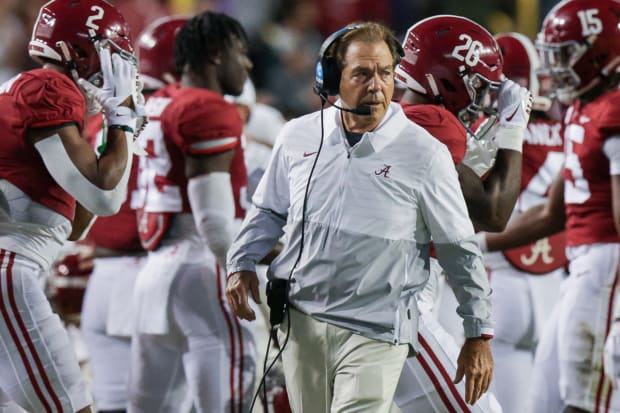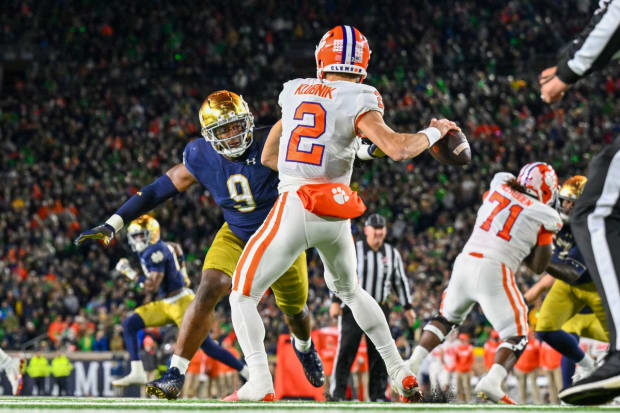The programs have been the face of the Playoff since it started. Is their era of dominance being threatened?
Forty names, games, teams and minutiae making news in college football (where the Cougars’ defense needs a lecture from Houston men’s basketball coach Kelvin Sampson, whose team gave up only 77 or more points twice last season):
MORE DASH: Playoff Paths
First Quarter
The Kings Are Dead … Long Live the King
It appears that for the first time in the nine-season College Football Playoff era, we may stage one with neither Alabama (1) nor Clemson (2). They have been the two dominant brands of the CFP’s previous eight years: The Crimson Tide made the bracket seven times and won three national titles; the Tigers have made it six times and won it all twice. Now, after both were upset Saturday, they’re on the outside looking in, needing a lot of help to change their circumstances.
But today there are bigger questions looming over both programs: Is their window of dominance closing? Is the heyday over? Is this the inevitable beginning of the inevitable end for a pair of dynasties?
Foolhardy as it might be to declare the demise of coaches with the stature of Nick Saban and Dabo Swinney, there are reasons to suspect they’ve reached a tipping point.
Of course, this is relative to program standards that are set absurdly high. Conference championships, Playoff berths and national championships are the expectation, and massive resources have been committed to attaining those goals at both schools. What could be considered slipping at Alabama and Clemson would be dream seasons almost everywhere else.
But nothing lasts forever, and both already have exceeded historical norms—nobody has sustained a run like Saban’s 14 seasons from 2008 to ’21, and few can match what Swinney accomplished from ’15 to ’20. Plus, just look at the product on the field.
For Alabama (7–2), two losses by a total of four points on the road against 8–1 Tennessee and 7–2 LSU is hardly a disaster. It could be argued that the Tide are two plays away from being undefeated. But it also could be argued that they are two plays away from being 5–4 after narrow escapes against Texas and Texas A&M. Split the difference in four 50–50 games and Bama probably has the record it deserves at this point.
The fact is this is the earliest the Tide have been (logically) eliminated from the Playoff race. The only other time Alabama missed the field, in 2019, the final blow came in the Iron Bowl against Auburn after a mid-November injury knocked out Tua Tagovailoa and left the season in the hands of then untested Mac Jones.
This season is tracking similarly to the 2010 Alabama team, which went 9–3 in the regular season and had its second loss to LSU in early November. That team is Saban’s only underachiever at the school.
The biggest warning signs hinting at slippage from this Bama team are in the areas of game management, penalties and defense. Fans are enthusiastically ripping coordinators Pete Golding and Bill O’Brien, but the problems seem to go higher. This just doesn’t resemble the buttoned-up machine we’re accustomed to seeing.

Stephen Lew/USA TODAY Sports
Saban’s in-game coaching decisions (3) have proven costly in both Alabama losses. He mismanaged the clock at the end against Tennessee—instead of taking it down to near-zero before attempting a go-ahead field goal, he left the Volunteers enough time for a final possession that resulted in a game-winning kick. And Saturday in Baton Rouge, Saban’s fourth-quarter decisions to chase points with a pair of two-point conversions backfired: both attempts failed, which meant Bama had to settle for a tying field goal in the final minute when it could have kicked the game-winner. Ultimately, the Tide lost in OT.
No coach gets every decision right, but to see Saban on the wrong side of those two is jarring. And perhaps telling.
In terms of penalties, Alabama can celebrate ending its streak of triple-digit penalty yardage in away games at four: they were flagged “only” nine times for 92 yards against LSU. The Tide is 125th nationally and last in the SEC in penalty yards per game—something a dominant team could perhaps get away with, but not one that is playing as many close games as Alabama is this season.
But perhaps the biggest departure of all from ‘Alabusiness As Usual’ is a defense that isn’t producing enough big plays—specifically, the extreme reduction in takeaways (4). From 2008 to ’21, the Tide averaged 25.2 takeaways per season. The total thus far this year: six. That’s last in the SEC and tied for 127th nationally, which is shocking for a Saban team. And LSU was the fourth opponent this season to not turn the ball over at all against Alabama, which is more than the previous three seasons combined.
This team was supposed to be elite defensively, with linebacker Will Anderson Jr. leading what was expected to be a vaunted pass rush and a secondary touted as one of the best in the nation. But the unit hasn’t done enough in the turnover department to turn close games into blowouts or losses into wins.
For Clemson (8–1), this could be its second straight season missing the Playoff (which it hasn’t done before). The Tigers still could get in the mix at 12–1, but their one loss is a bad one: They were blown out by an unranked Notre Dame team, 35–14. (The ACC’s top two teams have both lost to the Fighting Irish, who themselves lost to Marshall and Stanford. That will leave a mark on the Playoff résumé.) Saturday was Clemson’s largest margin of defeat in a non-Playoff game in eight years, dating back to before Swinney shifted the program into high gear.
Clemson’s issues are different from Alabama’s, but just as pronounced. Start with the obvious: quarterback play (5). When the Tigers were at their peak, they were led by two elite QBs in Deshaun Watson and Trevor Lawerence. Now, they’re deep in a two-year struggle at that position.
It’s better than last year, mostly because it can’t be worse. But it’s not up to the standard set by Watson and Lawrence, and the last two games against quality defenses (Syracuse and Notre Dame) were brutal. Clemson’s combined passing stats from those games: 42 of 65 for 348 yards with one touchdown and four interceptions, one of which was a 96-yard pick-six. Efficiency rating: 102.36, which is rough.
In both games, starter D.J. Uiagalelei was benched for freshman backup Cade Klubnik, which paid some dividends against the Orange, but not against the Irish. The Clemson QBs are missing a game-breaking receiver, as that unit has become pedestrian since the days of Tee Higgins, a healthy Justyn Ross and Amari Rodgers.

Matt Cashore/USA TODAY Sports
But the Clemson defensive front, touted as one of the best in the country, also came up small in South Bend. The Irish ran for 263 yards, the most the Tigers have allowed on the ground since the 2014 season opener. When the team’s strength gets mauled, there’s a problem.
Maybe staff turnover (6) is an issue after losing longtime coordinators Brent Venables and Tony Elliott. But last year’s team was worse than this one, and both those guys were on that staff. Still, it’s possible that someone who promotes internally the way Swinney does will eventually promote someone who isn’t up to the task—or at least not up to the task when not armed with overwhelming talent.
The 2020 Clemson recruiting class was supposed to keep that talent level at an elite level. It was ranked No. 2 in the nation and theoretically would sustain what had been built. The payoff hasn’t been there yet.
Watch college football live with fuboTV: Start a free trial today.
Four for the Playoff
Each week, The Dash decrees what the Playoff bracket should be if today were Selection Sunday. This week’s look:
Peach Bowl: top seed Georgia (7) vs. fourth seed TCU (8).
The Bulldogs (9–0) temporarily ended any debate about who’s No. 1 by pummeling previously undefeated Tennessee. Georgia deconstructed the Volunteers’ big-play passing attack while hitting several shots of its own, and the outcome of the game was never in doubt after halftime. Next up for Georgia: at Mississippi State on Saturday.
The Horned Frogs (9–0) customarily fell behind Saturday before eventually rallying to victory. The opponent this time was Texas Tech, and the response to a 17–13 fourth-quarter deficit was a 21-point explosion to put the game away. The Hypnotoads have outscored their opponents 55–14 in the fourth quarter of the last four games. Next up for TCU: at Texas in a big one.
Fiesta Bowl: second seed Ohio State (9) vs. third seed Michigan (10).
The Buckeyes (9–0) turned in their worst performance to date, wallowing past abysmal Northwestern 21–7 in a game that was junked up by the elements. C.J. Stroud didn’t help his Heisman Trophy campaign with his arm (10-of-26 for 76 yards) but did produce a big play with his legs: a 44-yard scramble to set up the go-ahead touchdown. Next up for Ohio State: home against Indiana in what should be a dreadful Big Noon Kickoff affair.
The Wolverines (9–0) messed around for a while against Rutgers, trailing going into the second half, but then scored the game’s final 38 points to win going away. Michigan has won every game but one by 13 or more points, and has held five straight opponents to 17 or fewer points. Next up for Michigan: Nebraska in the Big House on Saturday.
MORE DASH: Playoff Paths